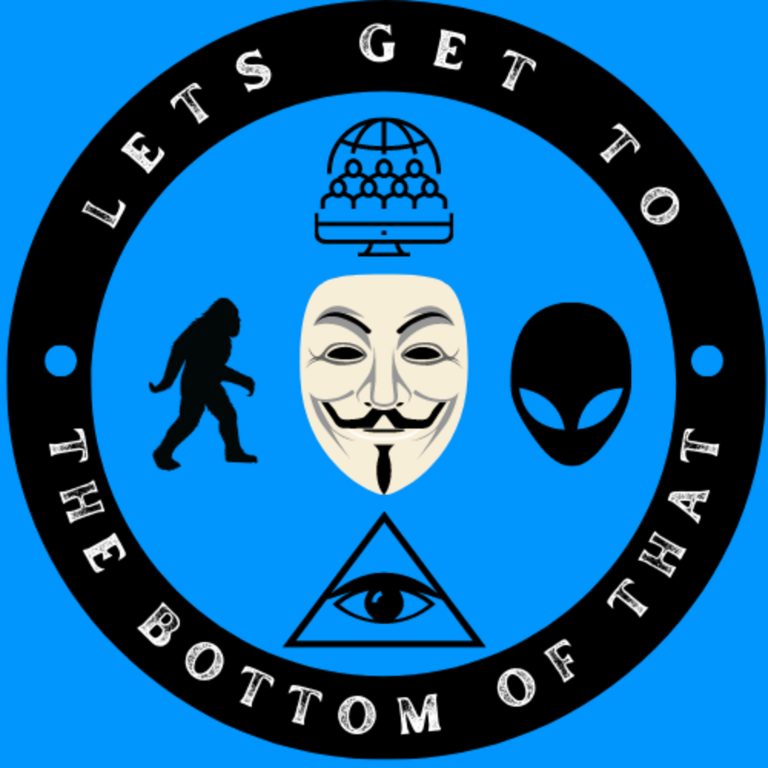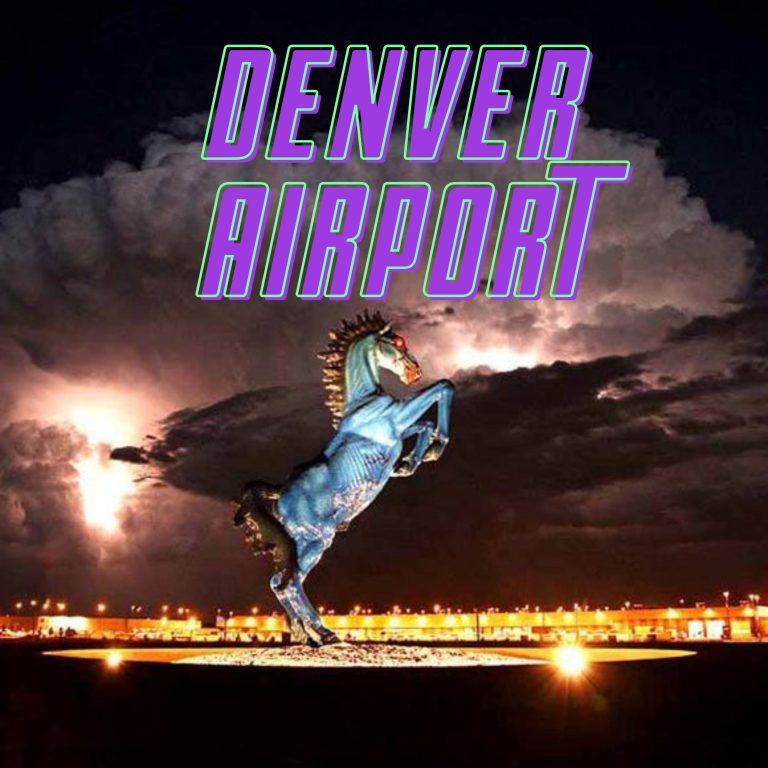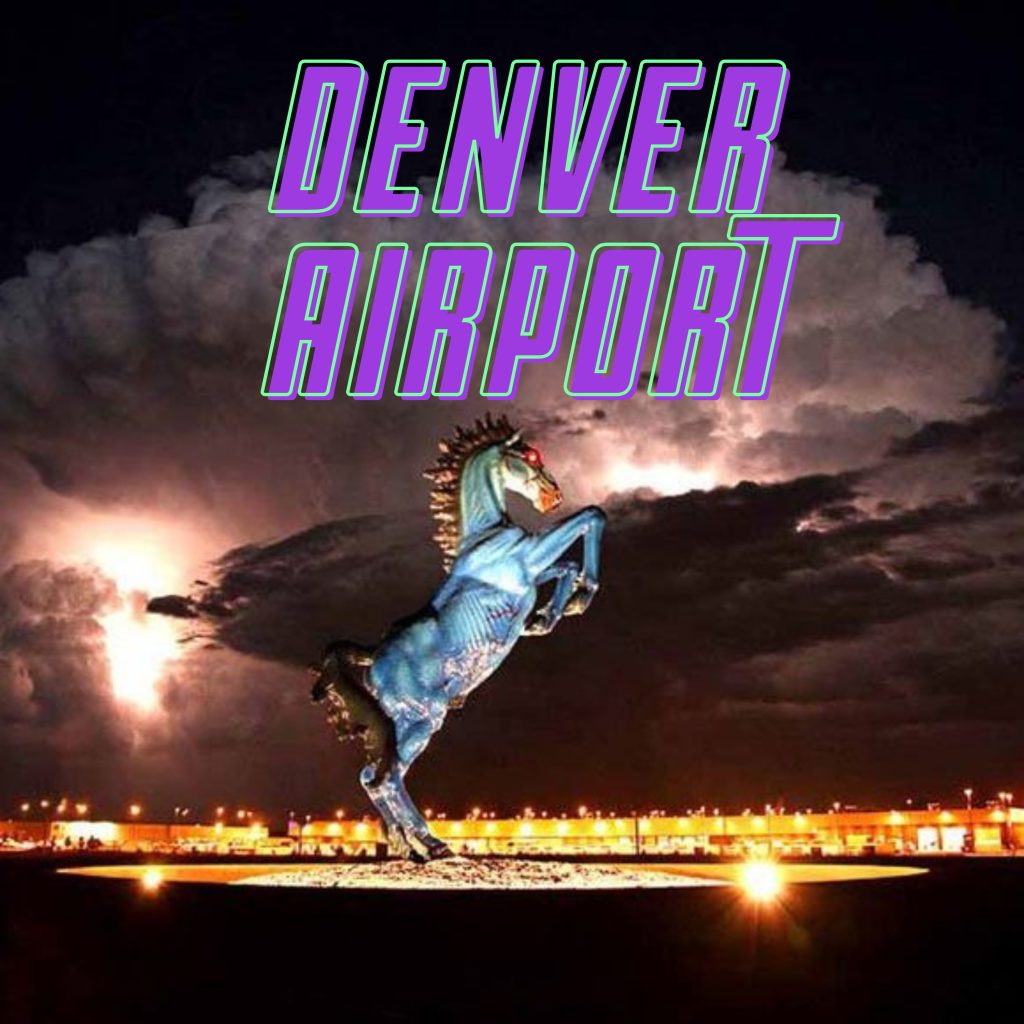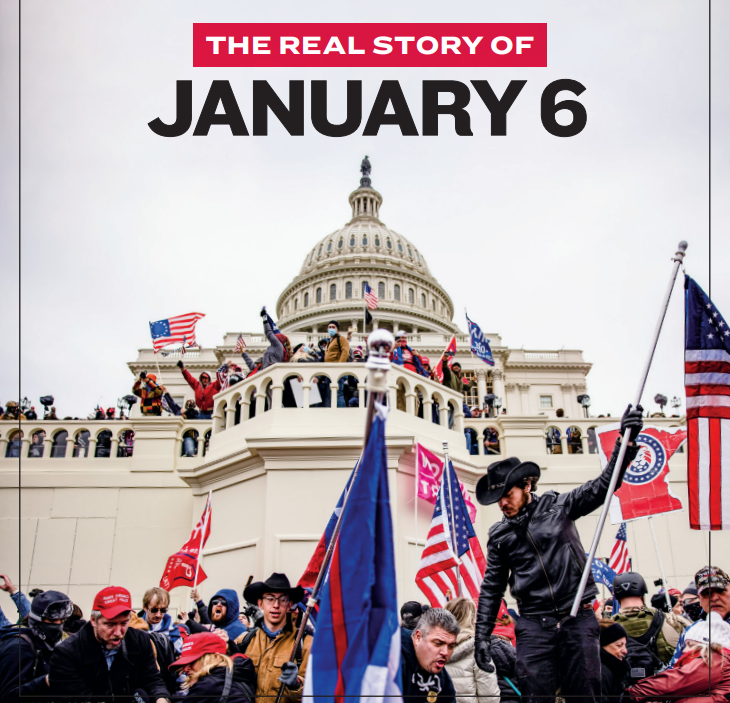
This show will get to the bottom of all those questions you need answers to. Each week, we will cover a topic that has been left unattended in the public square, with unanswered questions surrounding the “official story.” You will be able to determine on this show if the topic has been deemed a “Conspiracy” or a “Conspiracy Theory”.
If you want to support the show, you can become a subscriber and get access to bonus content. Click here to support https://creators.spotify.com/pod/profile/bottomofthat/subscribe
Denver Airport Denver International Airport (DIA) is an international airport located in Northeast Denver, Colorado, United States. It was opened on February 28, 1995, and is the largest airport in the Western Hemisphere by land area and the second largest on Earth, behind King Fahd International Airport. The airport has traditionally been home to one of the busiest airports in the United States because its midcontinent location was ideal for an airline hub 1. Denver International Airport replaced Stapleton International Airport, which had served as Denver’s primary airport for sixty-five years. The airport was renamed Stapleton, after the mayor who presided over its development, in 1944. The airport grew after World War II until it was the world’s fifth-busiest air hub by the 1980s. Stapleton International Airport, which served as Denver’s primary airport for sixty-five years, was replaced by Denver International Airport (DIA) in 1995. The decision to replace Stapleton was made due to several problems with the airport, including inadequate lateral separation between runways, leading to long waits during instrument-flight operations.
It has now become home to some of the most talked about conspiracies. Nazi runways, remote locations, underground bunkers, aliens, and artistic depictions of the apocalypse. Just to name a few.

Nazi runways, remote locations, underground bunkers, aliens and artistic depictions of the apocalypse
Secret societies
The theory: The Freemasons, a centuries-old secret society, has controlled the airport ever since it opened, with ties to the New World Order, a group of global elites who wield power over international affairs.
The history: A dedication plaque at the airport’s south entrance (near the Westin Hotel and RTD University of Colorado A-Line) dated March 19, 1994, contains a time capsule and bears the symbol of the Freemasons, as well as a reference to the New World Airport Commission. “Strange markings” have also been noted around the airport, supposedly indicating secret or alien languages.

The facts: While the Freemasons are a legitimate fraternal (and historically cloistered) organization with civic ties to the airport’s dedication, there is no evidence to suggest they have a hand in ongoing planning or decision-making at the civilian facility. Anti-Masonic conspiracies that date back more than a century were clearly dusted off and updated in advance of 2012’s “apocalypse fever.” The time capsule, to be opened in 2094, contains coins, a signed opening-day ball from Coors Field, Mayor Wellington Webb’s sneakers and a few Black Hawk casino tokens, among other items. The New World Airport Commission was named by Charles Ansbacher — an arts advocate who died in 2010. The name is a reference to Dvorák’s New World Symphony, according to a 2007 Westword article, and the Commission was created only to orchestrate DIA’s opening festivities. The “strange markings” are Navajo-language characters and references to other airport artists.
Artistic clues to the apocalypse
The theory: The airport’s 40-piece public art collection, most notably its colorful, 28-foot-wide murals by artist Leo Tanguma, its “Notre Denver” gargoyle sculptures near the east and west-side baggage claim areas, and the Mustang sculpture (a.k.a. big blue horse, or “Bluecifer”) near Peña Boulevard, are clues to a sinister influence at the airport, alternately credited as Illuminati, Freemasons, New World Order or Nazis.
The history: Like most DIA conspiracy theories, this one roughly parallels the rise of the internet at the time of the airport’s opening and has been given fuel over the years by radio hosts like George Noory, TV conspiracy-backer Ventura and many others. They point to Nazi or fascist imagery in Tanguma’s murals (on Level 5 of the Jeppesen Terminal), the ominous and seemingly random nature of the gargoyles, and the fact that a portion of the 32-foot, 9,000-pound Mustang sculpture (which features glowing red eyes, interpreted as reference to the Four Horsemen of the Apocalypse) fell on and killed its creator Luis Jiménez.
The facts: The meaning of Tanguma’s murals is frequently divorced from the context of their creation, which tells a hopeful story of peace and environmental stewardship following times of war and pollution. Conspiracy theorists focus only on the grim imagery but not the rainbow-laden resolution (read from right-to-left in the mural “Children of the World Dream of Peace”). The red eyes in the Mustang sculpture are an homage to the artist’s father, who worked with neon signs. “Hindsight’s 20/20, because it really could have been any color of neon,” said Heather Kaufman, director of arts and public events for DIA. And the gargoyles? They have historically been used as decorative yet functional downspouts, and in general, as longtime symbols of protection to ward off evil spirits. In DIA’s case, they’re playfully popping out of open suitcases on pillars.
Underground bunkers — and aliens
The theory: Hidden beneath the airport’s underground baggage-transport tunnels is a secret bunker (or series of bunkers) designed to house billionaires and global political elite in the event of an apocalypse. Lizard people (a.k.a. “Reptoids”) and/or evidence of aliens are also thought to be lurking down there.
The history: Contractors who originally worked on the airport, which went over budget and opened 16 months behind schedule, reportedly saw evidence of bunker entrances and unexplained tunnels. A multi-million dollar automated baggage system failed to work as designed, fueling doubts about the intent and scale of the construction. An “alien” drawing has appeared on the walls, and blurry footage of “lizard people” has appeared on conspiracy websites.
The facts: Roughly 1,000 people work daily in the various levels underneath the airport, ferrying luggage among ticket counters, planes and baggage claim areas in a pair of 7,000-foot long tunnels that run alongside the airport’s underground trains — which were not immediately ready to use upon the airport’s opening. As seen during a tour of the tunnels provided to The Denver Post, all plumbing and electrical infrastructure appears to end at the underground area’s lowest level; hiding anything else under it would be an engineering feat on par with the “Chunnel” that connects England to France. Furthermore, “Over the years, little personal touches have been made,” Montgomery said of the tunnels, pointing to the hand-drawn alien image (as well as decidedly non-alien-themed “graffiti” like smiley faces) as he drove an electric golf cart under the B concourse. The automated baggage system was actually used in various capacities, mostly by United Airlines, up until 2010. “There’s a certain mystique to anything you can’t see,” Montgomery said of the 470,000 square feet of underground space. “The fact of the matter is, it would take me three days to show you everything down here.” Finally, airport workers have been known to don lizard masks as pranks while the media are on tours — including one caught on camera by Fox 31 KDVR-Denver in a video that has since been circulated (often uncredited) as evidence of their existence.
Nazi runways, remote locations
The theory: DIA’s location, approximately 25 miles from downtown Denver, swastika-shaped runway configuration and various, barely concealed symbols of Nazism or fascism hint at any number of sinister plots, theorists say. Also, a tunnel is said to connect DIA to NORAD, nearly 100 miles to the south near Colorado Springs.
The history: Nazi conspiracy theories have been among the most popular online for the last two decades, and despite its recent, tongue-in-cheek embrace of most conspiracies, DIA officials have shied from directly addressing them — which some see as a sign of their validity. “We do have some subject matter that we wanted to either just avoid or tread very lightly with,” said DIA’s Kaufman, in response to a question about what made the cut for October’s exhibit in the main terminal. “Some things are worth debunking. Others aren’t.”
The facts: A close look at aerial photography of the supposedly swastika-shaped runaways reveals a lumpy, misshapen and largely interpretive swastika, at best. The rotating, fan-shaped design allows for optimal take-off into and against the wind from different directions, depending on weather and traffic patterns. Additionally, a 90-mile long tunnel from DIA’s remote location to NORAD seems highly unlikely and cost-prohibitive, given that the world’s longest underground rail tunnel — the newly opened, Swiss Alps-traversing Gotthard Base Tunnel — is less than half that length (35.4 miles) and took more than a decade to excavate and construct.
Conclusion
For people with vested interests in sowing doubt about institutions and organizations, the real fear might just be discovering there’s a mundane explanation for all these theories. Conspiracies create drama and excitement, allowing theorists to more clearly define (and usually reinforce) their existing beliefs. They feel alive, adrenalized, and righteous.
But a more complex, gray-area explanation of things may be the biggest unacknowledged threat to those with a stake in defining themselves against systems they don’t (or don’t want to) fully understand.
Theorists, for example, have never successfully addressed this notion: If the airport and its backers have spent decades and billions of dollars hiding secret, global plots and infrastructure, why jeopardize that work by putting so many obvious clues in plain sight?
“No matter what you do, you lose,” Mongtomery said. “You show people the tunnels and explain the symbols, you lose. You clam up and deny it, you lose. So that’s why we’ve started to have fun with these, because people are going to believe what they believe, regardless of hard evidence.”
It was opened on February 28, 1995, and is the largest airport in the Western Hemisphere by land area and the second largest on Earth, behind King Fahd International Airport 1. The airport has traditionally been home to one of the busier airports in the United States because its midcontinent location was ideal for an airline hub 1. Denver International Airport replaced Stapleton International Airport, which had served as Denver’s primary airport for sixty-five years 2.
The airport was renamed Stapleton, after the mayor who presided over its development, in 1944. The airport grew after World War II, until it was the world’s fifth-busiest air hub by the 1980s. Stapleton International Airport, which served as Denver’s primary airport for sixty-five years, was replaced by Denver International Airport (DIA) in 1995 12. The decision to replace Stapleton was made due to several problems with the airport, including inadequate lateral separation between runways, leading to long waits during instrument-flight operations 2.
Additionally, the airport was unable to keep up with the ever-increasing demand for international air traffic, the size of jet aircraft, or the land necessary to support continuous expansion. https://www.bing.com/th?id=OSK.be9fd51063334e0c5576e99593276746&pid=cdx&w=255 &h=189&c=7
Denver International Airport (DIA) was built to replace Stapleton International Airport, which had served as Denver’s primary airport for sixty-five years 1. The airport was opened on February 28, 1995, and is the largest airport in the Western Hemisphere by land area and the second largest on Earth, behind King Fahd International Airport 2. 1
The construction of DIA was plagued with setbacks and controversies. The airport was originally scheduled to open in October 1993, but the opening was delayed several times due to various issues, including problems with the baggage system and concerns about the airport’s safety 1. The airport eventually opened in February 1995, more than a year behind schedule and $2 billion over budget 1.
Known Facts about the Baggage System Purpose and Construction:
The tunnels at DIA were originally built as part of an automated baggage system, which was one of the most technologically advanced systems at the time of the airport’s construction. However, this system never fully functioned as intended and was plagued by operational issues. Extent and Usage: The tunnel system is extensive, stretching beneath the airport. Today, these tunnels are used for various logistical and operational purposes, including transportation of baggage and airport maintenance activities. Access and Security: Access to the tunnels is restricted, and they are not open to the public. The airport maintains tight security around these areas due to their importance in airport operations.
Art Installations
Mustang Statue: One of the most notable pieces is “Mustang,” a 32-foot tall sculpture of a blue horse with glowing red eyes, located near the entrance to the airport. 2 Description and Features “Mustang” is a 32-foot-tall, brightly colored blue sculpture of a rearing horse. It is notable for its vibrant blue color and glowing red eyes, which give it a distinctive and somewhat eerie appearance.
Artist: The sculpture was created by Luis Jiménez, an American artist known for his large, colorful works of public art. Location: It’s located near the main road leading to the airport, making it one of the first things visitors see as they approach DIA. Background and Significance Commission and Installation: “Mustang” was commissioned as part of the airport’s public art program and was installed in 2008.
Scriptural Basis: The primary reference to the Pale Horse is found in Revelation 6:7-8. In these verses, as the Lamb (interpreted as Jesus Christ) opens the fourth of seven seals, a pale horse appears. The color of the horse is often described as “pale,” “ashen,” or “pale green” in various translations, deriving from the original Greek word “chloros,” which can mean greenish-yellow or pale.
Rider Named Death: The rider of the Pale Horse is named Death. This is explicitly stated in the scripture, making the symbolism of this horseman quite direct. Power and Association: The passage states that Hades (the realm of the dead) follows with the rider, and they are given power over a fourth of the earth. The power granted includes the ability to kill with sword, famine, plague, and by wild beasts. Artist’s Death: The sculpture’s creation is marked by a tragic event; Luis Jiménez died in an accident while working on the piece. A section of the sculpture fell on him, causing fatal injuries. 3 This unfortunate event has contributed to the mystique surrounding the sculpture. Public Reception: The sculpture has received mixed reactions from the public.
While some appreciate it as a bold piece of public art, others find its appearance unsettling, especially due to the glowing red eyes. It has become a topic of local and even international discussion. Conspiracy Theories and Legends: In line with various conspiracy theories surrounding Denver International Airport, “Mustang” has also been subject to speculation.
Its imposing appearance and the tragic circumstances of the artist’s death have fueled various stories and legends, adding to the airport’s aura of mystery.
Cultural Impact: Despite—or perhaps because of—its controversial nature, “Mustang” has become an iconic symbol of Denver International Airport. It represents the city’s willingness to embrace bold, unconventional art.
Murals: Inside the airport, there are several murals by artist Leo Tanguma that have become the subject of much speculation. These murals, which include “In Peace and Harmony with Nature” and “The Children of the World Dream of Peace,” depict various scenes that some interpret as symbolic representations of apocalyptic and warlike themes. While intended to address themes of peace and environmental stewardship, their sometimes disturbing imagery has fueled alternative interpretations. Conspiracy Theories The unique art pieces, along with other aspects of the airport, have sparked numerous conspiracy theories: Apocalyptic Predictions:
Some believe the murals depict future world destruction and a new world order. This interpretation is often linked to the unsettling imagery in the paintings. Underground Facilities: There are rumors of underground bunkers and tunnels beneath the airport, purportedly built as a haven for the global elite in case of a catastrophe. This theory is bolstered by the fact that DIA’s construction went significantly over budget and schedule, leading some to speculate about the nature of the construction.
4 Masonic and Illuminati Symbols:
The presence of a capstone in the airport inscribed with a Masonic symbol and mentioning the “New World Airport Commission” has led to theories about connections to the Freemasons or the Illuminati. Some conspiracy theorists believe this implies secretive control over the airport’s construction and purpose.
Alien and Reptilian Associations: More extreme theories include suggestions that the airport is connected to extraterrestrial beings or that it houses reptilian creatures living in its supposed underground lairs. Official Responses and Public Perception The airport officials have responded to these theories with a mix of amusement and efforts to debunk them. They’ve even incorporated the conspiracy theories into their marketing and public relations strategies, recognizing the intrigue they generate. Despite the wild nature of these theories, they have become a part of the cultural identity of the airport, attracting curiosity and attention from visitors and enthusiasts of the unexplained.
Masonic Capstone The most prominent link between DIA and the Freemasons is a capstone located in the airport. This capstone contains a Masonic symbol and mentions the
“New World Airport Commission“. The details are as follows: Inscription and Symbol: The capstone includes a Masonic square and compasses symbol, which is a recognized emblem of Freemasonry. Additionally, it bears an inscription mentioning the “New World Airport Commission,” a group that, intriguingly, doesn’t appear to exist outside this context. Time Capsule: Beneath this capstone is a time capsule, which is meant to be opened in 2094. The contents of the capsule are not fully disclosed to the public, adding to the mystery. 5 Interpretations and Conspiracy Theories Masonic Influence: Some conspiracy theorists suggest that the Masonic symbol and the mention of the “New World Airport Commission” indicate a secretive influence of the Freemasons in the design and construction of the airport. They speculate about the Masons having a hidden agenda or symbolic messages encoded in the airport’s architecture and art.
Misinterpretations: However, it’s also possible that the Freemason involvement is simply part of the ceremonial aspect of laying the capstone, a common practice in many public buildings. Freemasons historically have been involved in such ceremonies, without necessarily implying any deeper influence or control. Official Responses Airport and Masonic Statements: Both Denver International Airport and Masonic organizations have clarified that the presence of the capstone is ceremonial and traditional, with no hidden implications. They emphasize that the Masonic symbol is part of a longstanding tradition of Masonic involvement in public building projects, rather than evidence of any clandestine influence. In summary, while there is a visible Masonic symbol and a reference to an enigmatic commission at Denver International Airport, these are likely ceremonial and traditional elements rather than indications of any secretive Masonic control or influence over the airport. The connection has become a focal point for various conspiracy theories, but official explanations suggest a more mundane reality.


